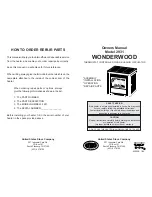
32
Operation
Permissible fuels
The following fuels are approved:
●
Natural shopped wood in the form of billet wood
Maximum length: .....................33 cm
Circumference: .......... approx. 30 cm
●
Wood briquettes to DIN EN 14691
Size class HP 2
Maximum length: .....................20 cm
Billet wood
reaches a moisture content of 10 to 15% after
being stored outdoors for 2 to 3 years (only covered at the
top) and is then ideally suited for heating.
Freshly cut wood
has a very high moisture content and
so burns badly. Apart from the very low calorific value it is
also harmful for the environment. The increased conden-
sate and tar formation can lead to fireplace and chimney
sooting.
This diagram shows that the consumption rate with fresh-
ly-felled wood (calorific value 2.3 kWh/kg) is almost twice
as high as the consumption rate with dry wood (calorific
value 4.3 kWh/kg).
Moisture [%]
dry wood that has been stored for at least 2 years
Caloric value [kWh/kg]
freshly-felled wood
You will only achieve optimum combustion and heat in
an environmentally friendly way with these fuels. Adding
the fuel in small quantities avoids unnecessary emissions.
Clean burning can be identified by the fact that the fire-
brick becomes a light colour.
According to the German Federal Immission Control Act,
it is forbidden e.g. to burn the following fuels in stoves:
●
Moist wood or wood treated with wood
preservatives
●
Sawdust, chippings, grinding dust
●
Bark and chipboard waste
●
Slack coal
●
Other wastes
●
Paper and cardboard (except for igniting)
●
Straw
Please note before heating for the first time
●
Remove all accessories from the ash pan and combus-
tion chamber.
●
The odour given off by the evaporation of the protec-
tive coating disappears after the stove has been burn-
ing for several hours (ventilate the room well).
●
The stove has a high quality temperature resistant coat,
which does not achieve its final strength until the stove
has been heated for the first time. You should therefore
never leave anything on the stove and not touch the
surfaces as the paint coat could otherwise be damaged.
●
As soon as the kindling material has burned down, put
on 2 burnouts consisting of 3 kg wood ensuring that the
temperature resistant coating reaches its final firmness.
Igniting
●
Before ignition, check that no flammable objects are
placed on the stove.
●
Empty the ash pan if necessary and slide back in.
●
Open the combustion air slide valve complete.
●
Grate in open position = operating lever pulled out
●
Stack small amounts of firewood and, on top of it, kin-
dling material (ignition cubes and dry, smaller ignition
wood) and ignite it.
●
Close the door to the combustion chamber so that the
kindling material can catch fire.
●
Once there is a basic firebed, add more fuel according to
the heat requirement (see chapter “Heating”).
Caution:
When heating up the fireplace, difficulties in igniting the
firewood can occur if a flue draught has not yet formed in
the chimney, and ventilation devices/systems are operat-
ed at the same time. In this case briefly opening a window
in the installation room or temporarily switching off the
ventilation system can help.
















































